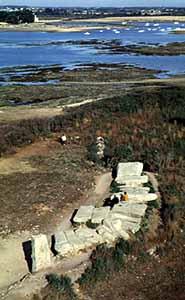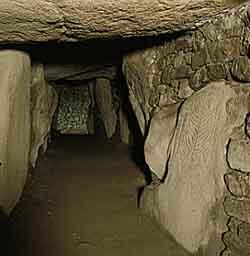- Home
- Megalithism in Morbihan
- Locmariaquer
- Pierres-plates (Flat Stones), a late tomb
- Introduction
- Carnac
- Gavrinis
-
Locmariaquer
- The peninsula and its monuments
- A cradle of archeological research
- Before the megaliths
- Grand-Menhir (Great Menhir)
- Er-Grah Tumulus
- La Table-des-Marchands (Merchants’s table)
- From Mané-Lud to Mané-er-Hroeg
- Pierres-plates (Flat Stones), a late tomb
- Megalithic art in Locmariaquer
- Locmariaquer, from Antiquity to the Middle Ages
- Le Petit-Mont
- Architectural types
Around 3000 B.C, megalithic "elbow" or "angled " tombs began to appear all along the Morbihan coastline, in close proximity to the sea.
One of the most beautiful examples of these is the Pierres-Plates monument which stands at the southern end of the Locmariaquer peninsula.
Other monuments (le Goerem at Gâvres or Kernours at Le Bono for instance) can help throw light on the architecture of Pierres-Plates. The latter has undergone extensive restoration and its cairn is missing:
the entire (7m long) terminal section consists of a large, elongated funeral chamber,
the slightly narrower entrance passage takes up approximately a third of the gallery, and is more oblique in relation to the chamber,
a little "closet" is located in the elbow of the main structure.
As in other elbow tombs, walling is "mixed"; i.e. small stone-built panels contained between megalithic uprights.
The cover consists of small narrow granite slabs (many of which have probably been replaced). The last one is a larger orthogneiss slab probably taken from some older monument.
The mound which now covers the tomb is mainly the work of Z. Le Rouzic who restored it in 1931.
In the light of the almost untouched Gâvres monument, it is possible that the gallery was protected by a smallish mound with a large rocky core.
The "indicator menhir" standing at the entrance is a block that lay in front of the monument and was erected here by Le Rouzic when he carried out the restoration work. Its original role in the structure is not well known but it can be noted that its eastern face carries a large number of cupmarks.
The monument was first explored in 1813 but the findings were disappointing because of previous incursions.
Nonetheless, these early explorers noticed that several uprights were decorated, leading to the first real record of megalithic art in the Morbihan, published by A. Maudet de Penhouet in 1814.
The decoration was frequently studied, but has since been broken up (at least one major panel disappeared). These studies provided the basis for the definition of the "Pierres-plates style"which is thought to characterize the Morbihan elbow tombs.
Aerial view of Pierres-Plates.
The elongated Pierres-Plates chamber, with walls made up of alternating standing slabs and stone-built panels.
One of the "idols" which characterize the "Pierres-Plates style".


